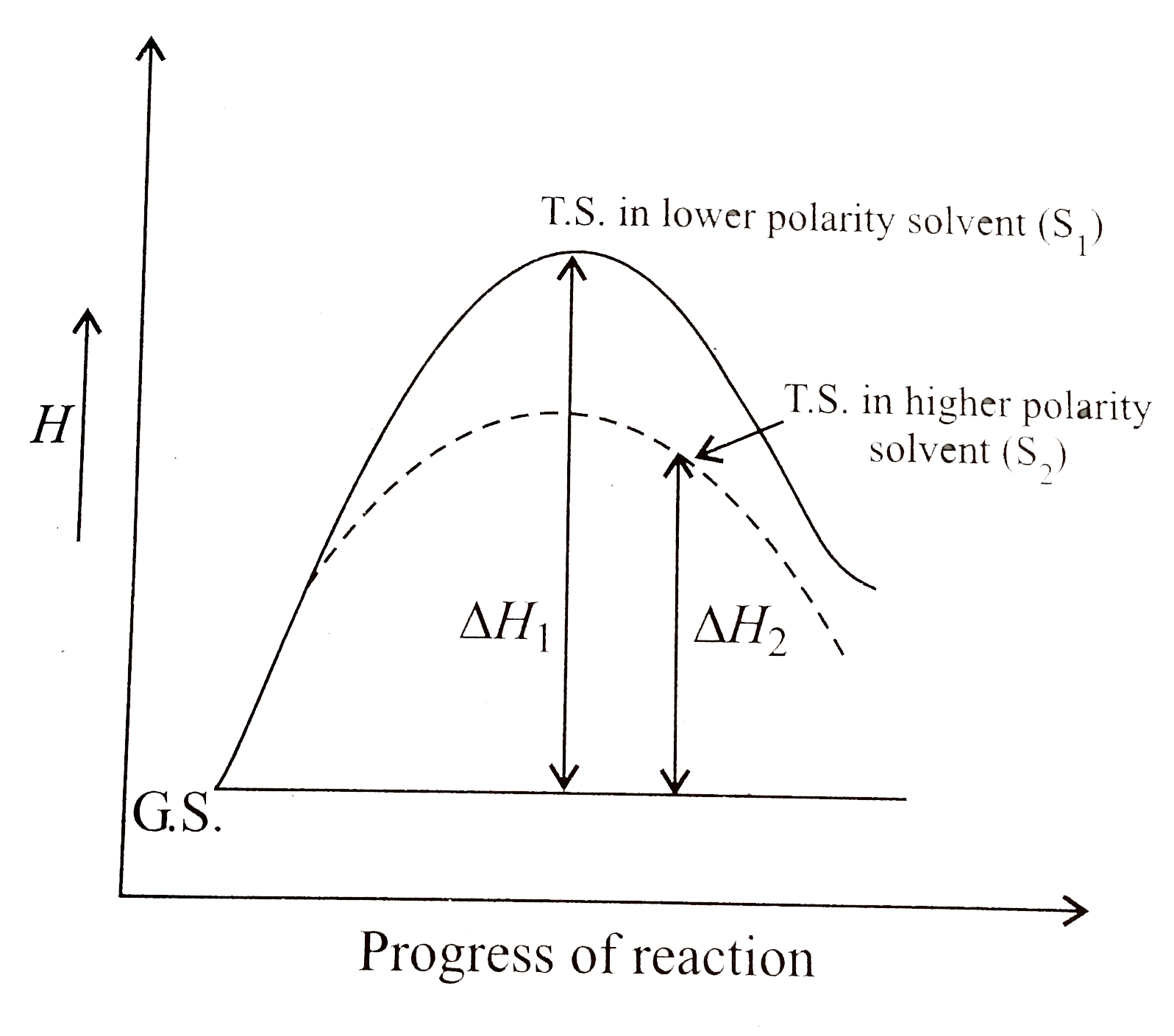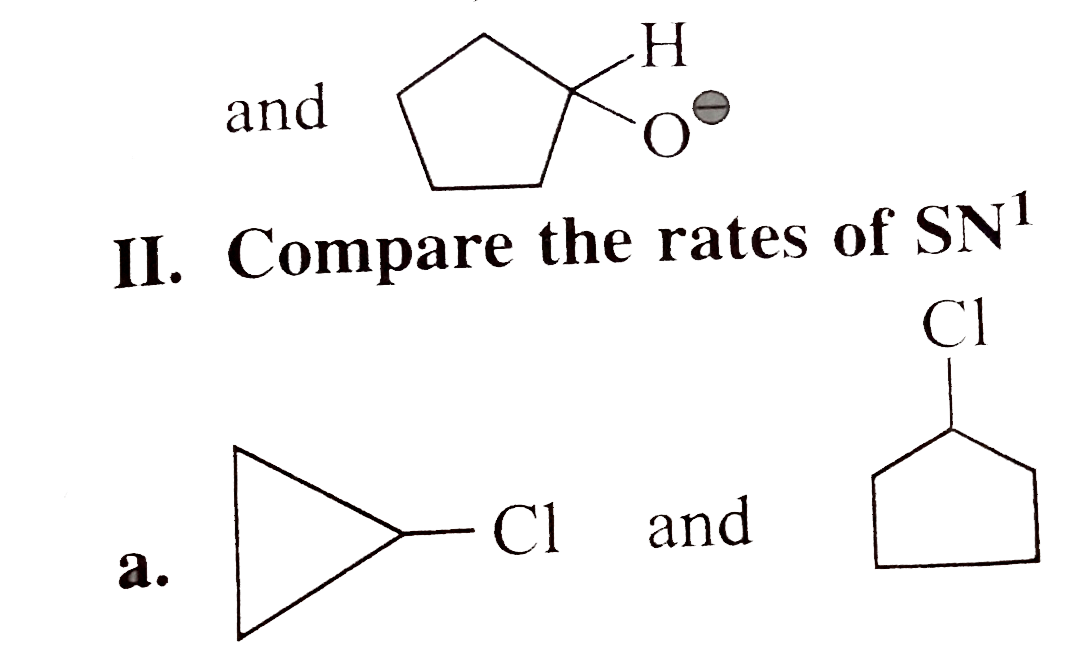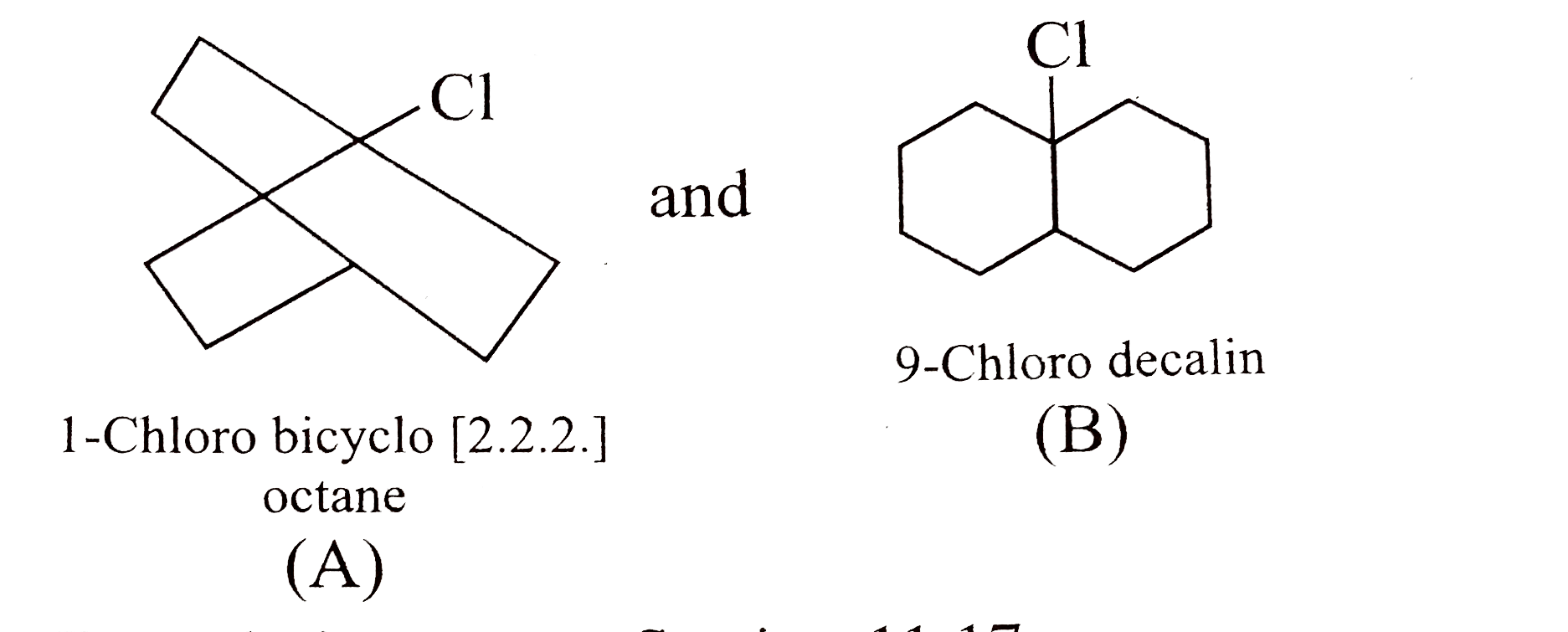(a) Show by enthalpy diagram the rate of solvolysis of t−BuCl on increasing the polarity of solvent.
(b) Give the equation of methanolysis of [Me3CSMe2]⊕BrӨ.
(c) Does the effect of solvent prevail for solvolysis of [Me3CSMe2]⊕ ?
(a) 
(b)  .
.
(c) No effect of solvent. The G.S sulphonium cation has a full positive charge. HGS is lowered more than HT.S. Since in the T.S., the positive charge is more diffused, the rate decreases with increase of polarity of solvent [unlike in (a)].
Topper's Solved these Questions
- BOOK - CENGAGE CHEMISTRYCHAPTER - ORGANIC REACTION MECHANISMEXERCISE - Subjective19videos
ORGANIC REACTION MECHANISM
- BOOK - CENGAGE CHEMISTRYCHAPTER - ORGANIC REACTION MECHANISMEXERCISE - Comprehension36videos
ORGANIC REACTION MECHANISM
- BOOK - CENGAGE CHEMISTRYCHAPTER - ORGANIC REACTION MECHANISMEXERCISE - Analytical and Descriptive6videos
ORGANIC REACTION MECHANISM
- BOOK - CENGAGE CHEMISTRYCHAPTER - NCERT BASED EXERCISEEXERCISE - Chemical Equilibrium72videos
NCERT BASED EXERCISE
- BOOK - CENGAGE CHEMISTRYCHAPTER - P-BLOCK GROUP 13 - BORON FAMILYEXERCISE - Exercise Archives (Subjecive)9videos
P-BLOCK GROUP 13 - BORON FAMILY
Similar Questions
Explain the effect of SN2 rates for the following reactions :
(a) Increasing the polarity of solvent.
(b) Show the T.S with all partial charges for each reaction type.
(I) Me2⊕S−Me+NH3→Me⊕NH3+Me2S
(II) MeI+NH3→Me⊕NH3+IӨ
(III) MeI+ӨOH→MeOH+IӨ
(IV) Me2S⊕−Me+ӨOH→MeOH+Me2S.View Solution(a) Compare the reactivity of Me3COӨK⊕ and EtNH2 in E2 reaction.
(b) Why is Me3COӨK⊕ superior to EtOӨ in E2 reaction ?
(c) Compare the effectiveness of Me3COӨK⊕ in DMSO and Me3COH as solvents.
(d) Me2CC1CH2CH3Me3COӨK⋅−−−−−−−→ Major alkene.View Solution
Knowledge Check
- Question 1 - Select One
Read the passage given below and answer the following questions:
Nucleophilic substitution reaction of haloalkane can be conducted according to both S1N and S2N mechanisms. However, which mechanism it is based on is related to such factors as the structure of haloalkane, and properties of leaving group, nucleophilic reagent and solvent.
Influences of halogen : No matter which mechanism the nucleophilic substitution reaction is based on, the leaving group always leave the central carbon atom with electron pair. This is just the opposite of the situation that nucleophilic reagent attacks the central carbon atom with electron pair. Therefore, the weaker the alkalinity of leaving group is , the more stable the anion formed is and it will be more easier for the leaving group to leave the central carbon atom, that is to say, the reactant is more easier to be substituted. The alkalinity order of halogen ion is I−<Br−<Cl−<F− and the order of their leaving tendency should be I−>Br−>Cl−>F− . Therefore, in four halides with the same alkyl and different halogens, the order of substitution reaction rate is RI>RBr>RCl>RF . In addition, if the leaving group is very easy to leave, many carbocation intermediates are generated in the reaction and the reaction is based on S1N mechanism. If the leaving group is not easy to leave, the reaction is based on S2N mechanism.
Influences of solvent polarity: In S1N reaction, the polarity of the system increases from the reactant to the transition state, because polar solvent has a greater stabilizing effect on the transition state than the reactant, thereby reduce activation energy and accelerate the reaction. In S2N reaction, the polarity of the system generally does not change from the reactant to the transition state and only charge dispersion occurs. At this time, polar solvent has a great stabilizing effect on Nu than the transition state, thereby increasing activation energy and slow down the reaction rate. For example, the decomposition rate (S1N) of tertiary chlorobutane in 25∘C water (dielectric constant 79) is 300000 times faster than in ethanol (dielectric constant 24). The reaction rate (S2N) of 2-bromopropane and NaOH in ethanol containing 40% water is twice slower than in absolute ethanol. In a word, the level of solvent polarity has influence on both S1N and S2N reactions, but with different results. Generally speaking, weak polar solvent is favorable for S2N reaction, while strong polar solvent is favorable for S1N reaction, because only under the action of polar solvent can halogenated hydrocarbon dissociate into carbocation and halogen ion and solvents with a strong polarity is favorable for solvation of carbocation, increasing its stability. Generally speaking, the substitution reaction of tertiary haloalkane is based on S1N mechanism in solvents with a strong polarity (for example, ethanol containing water).
(Ding, Y. (2013). A Brief Discussion on Nucleophilic Substitution Reaction on Saturated Carbon Atom. In Applied Mechanics and Materials (Vol. 312, pp. 433-437). Trans Tech Publications Ltd.)
Nucleophilic substitution will be fastest in case of:A1-Chloro-2,2-dimethyl propaneB1-Iodo-2,2-dimethyl propaneC1-Bromo-2,2-dimethyl propaneD1-Fluoro-2,2-dimethyl propane - Question 2 - Select One
Read the passage given below and answer the following questions:
Nucleophilic substitution reaction of haloalkane can be conducted according to both S1N and S2N mechanisms. However, which mechanism it is based on is related to such factors as the structure of haloalkane, and properties of leaving group, nucleophilic reagent and solvent.
Influences of halogen : No matter which mechanism the nucleophilic substitution reaction is based on, the leaving group always leave the central carbon atom with electron pair. This is just the opposite of the situation that nucleophilic reagent attacks the central carbon atom with electron pair. Therefore, the weaker the alkalinity of leaving group is , the more stable the anion formed is and it will be more easier for the leaving group to leave the central carbon atom, that is to say, the reactant is more easier to be substituted. The alkalinity order of halogen ion is I−<Br−<Cl−<F− and the order of their leaving tendency should be I−>Br−>Cl−>F− . Therefore, in four halides with the same alkyl and different halogens, the order of substitution reaction rate is RI>RBr>RCl>RF . In addition, if the leaving group is very easy to leave, many carbocation intermediates are generated in the reaction and the reaction is based on S1N mechanism. If the leaving group is not easy to leave, the reaction is based on S2N mechanism.
Influences of solvent polarity: In S1N reaction, the polarity of the system increases from the reactant to the transition state, because polar solvent has a greater stabilizing effect on the transition state than the reactant, thereby reduce activation energy and accelerate the reaction. In S2N reaction, the polarity of the system generally does not change from the reactant to the transition state and only charge dispersion occurs. At this time, polar solvent has a great stabilizing effect on Nu than the transition state, thereby increasing activation energy and slow down the reaction rate. For example, the decomposition rate (S1N) of tertiary chlorobutane in 25∘C water (dielectric constant 79) is 300000 times faster than in ethanol (dielectric constant 24). The reaction rate (S2N) of 2-bromopropane and NaOH in ethanol containing 40% water is twice slower than in absolute ethanol. In a word, the level of solvent polarity has influence on both S1N and S2N reactions, but with different results. Generally speaking, weak polar solvent is favorable for S2N reaction, while strong polar solvent is favorable for S1N reaction, because only under the action of polar solvent can halogenated hydrocarbon dissociate into carbocation and halogen ion and solvents with a strong polarity is favorable for solvation of carbocation, increasing its stability. Generally speaking, the substitution reaction of tertiary haloalkane is based on S1N mechanism in solvents with a strong polarity (for example, ethanol containing water).
(Ding, Y. (2013). A Brief Discussion on Nucleophilic Substitution Reaction on Saturated Carbon Atom. In Applied Mechanics and Materials (Vol. 312, pp. 433-437). Trans Tech Publications Ltd.)
S1N mechanism is favoured in which of the following solvents:AbenzeneBcarbon tetrachlorideCacetic acidDcarbon disulphide - Question 3 - Select One
Read the passage given below and answer the following questions:
Nucleophilic substitution reaction of haloalkane can be conducted according to both S1N and S2N mechanisms. However, which mechanism it is based on is related to such factors as the structure of haloalkane, and properties of leaving group, nucleophilic reagent and solvent.
Influences of halogen : No matter which mechanism the nucleophilic substitution reaction is based on, the leaving group always leave the central carbon atom with electron pair. This is just the opposite of the situation that nucleophilic reagent attacks the central carbon atom with electron pair. Therefore, the weaker the alkalinity of leaving group is , the more stable the anion formed is and it will be more easier for the leaving group to leave the central carbon atom, that is to say, the reactant is more easier to be substituted. The alkalinity order of halogen ion is I−<Br−<Cl−<F− and the order of their leaving tendency should be I−>Br−>Cl−>F− . Therefore, in four halides with the same alkyl and different halogens, the order of substitution reaction rate is RI>RBr>RCl>RF . In addition, if the leaving group is very easy to leave, many carbocation intermediates are generated in the reaction and the reaction is based on S1N mechanism. If the leaving group is not easy to leave, the reaction is based on S2N mechanism.
Influences of solvent polarity: In S1N reaction, the polarity of the system increases from the reactant to the transition state, because polar solvent has a greater stabilizing effect on the transition state than the reactant, thereby reduce activation energy and accelerate the reaction. In S2N reaction, the polarity of the system generally does not change from the reactant to the transition state and only charge dispersion occurs. At this time, polar solvent has a great stabilizing effect on Nu than the transition state, thereby increasing activation energy and slow down the reaction rate. For example, the decomposition rate (S1N) of tertiary chlorobutane in 25∘C water (dielectric constant 79) is 300000 times faster than in ethanol (dielectric constant 24). The reaction rate (S2N) of 2-bromopropane and NaOH in ethanol containing 40% water is twice slower than in absolute ethanol. In a word, the level of solvent polarity has influence on both S1N and S2N reactions, but with different results. Generally speaking, weak polar solvent is favorable for S2N reaction, while strong polar solvent is favorable for S1N reaction, because only under the action of polar solvent can halogenated hydrocarbon dissociate into carbocation and halogen ion and solvents with a strong polarity is favorable for solvation of carbocation, increasing its stability. Generally speaking, the substitution reaction of tertiary haloalkane is based on S1N mechanism in solvents with a strong polarity (for example, ethanol containing water).
(Ding, Y. (2013). A Brief Discussion on Nucleophilic Substitution Reaction on Saturated Carbon Atom. In Applied Mechanics and Materials (Vol. 312, pp. 433-437). Trans Tech Publications Ltd.)
S1N reaction will be fastest in case of:A1-Chloro-2-methyl propaneB1-Iodo-2-methyl propaneC1-ChlorobutaneD1-Iodobutane
Predict the effect of increasing the percentage of H2O in acetone −H2O solvent mixture in :
(a) SN1 solvolysis of Me3C−Br
(b) SN2 reaction of K1 and EtC1.
(c) Predict the relative yields of the product of Me3CBr in 80%EtOH and 20%H2O.View Solution(I) Give the decreasing order of SN2 reacivity of the following alkoxide nucleophile.
Me3COӨ,MeCH2OӨ,Me2CHOӨ
and (b)
(b)  .View Solution
.View Solution(a) Give the Claisen ester condensation product of ethyl butanoate.
(b) Why does the Claisen ester condensation of ethyl-2-methyl propanoate (I) not take place ?
( c) Why does Claisen condensation of (I) take place by the use of Ph3CӨNa⊕ as a base ?View SolutionWrite increasing order of basic strength of following:
(a)NH3 (b)MeNH2
(c)Me2NH (d)Me3N( inH2O)View SolutionRead the passage given below and answer the following questions:
Nucleophilic substitution reaction of haloalkane can be conducted according to both S1N and S2N mechanisms. However, which mechanism it is based on is related to such factors as the structure of haloalkane, and properties of leaving group, nucleophilic reagent and solvent.
Influences of halogen : No matter which mechanism the nucleophilic substitution reaction is based on, the leaving group always leave the central carbon atom with electron pair. This is just the opposite of the situation that nucleophilic reagent attacks the central carbon atom with electron pair. Therefore, the weaker the alkalinity of leaving group is , the more stable the anion formed is and it will be more easier for the leaving group to leave the central carbon atom, that is to say, the reactant is more easier to be substituted. The alkalinity order of halogen ion is I−<Br−<Cl−<F− and the order of their leaving tendency should be I−>Br−>Cl−>F− . Therefore, in four halides with the same alkyl and different halogens, the order of substitution reaction rate is RI>RBr>RCl>RF . In addition, if the leaving group is very easy to leave, many carbocation intermediates are generated in the reaction and the reaction is based on S1N mechanism. If the leaving group is not easy to leave, the reaction is based on S2N mechanism.
Influences of solvent polarity: In S1N reaction, the polarity of the system increases from the reactant to the transition state, because polar solvent has a greater stabilizing effect on the transition state than the reactant, thereby reduce activation energy and accelerate the reaction. In S2N reaction, the polarity of the system generally does not change from the reactant to the transition state and only charge dispersion occurs. At this time, polar solvent has a great stabilizing effect on Nu than the transition state, thereby increasing activation energy and slow down the reaction rate. For example, the decomposition rate (S1N) of tertiary chlorobutane in 25∘C water (dielectric constant 79) is 300000 times faster than in ethanol (dielectric constant 24). The reaction rate (S2N) of 2-bromopropane and NaOH in ethanol containing 40% water is twice slower than in absolute ethanol. In a word, the level of solvent polarity has influence on both S1N and S2N reactions, but with different results. Generally speaking, weak polar solvent is favorable for S2N reaction, while strong polar solvent is favorable for S1N reaction, because only under the action of polar solvent can halogenated hydrocarbon dissociate into carbocation and halogen ion and solvents with a strong polarity is favorable for solvation of carbocation, increasing its stability. Generally speaking, the substitution reaction of tertiary haloalkane is based on S1N mechanism in solvents with a strong polarity (for example, ethanol containing water).
(Ding, Y. (2013). A Brief Discussion on Nucleophilic Substitution Reaction on Saturated Carbon Atom. In Applied Mechanics and Materials (Vol. 312, pp. 433-437). Trans Tech Publications Ltd.)
Polar solvents make the reaction faster as they:View Solution

